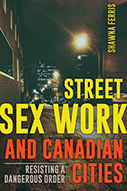Street Sex Work and Canadian Cities: Resisting a Dangerous Order

Author: Shawna Ferris
Publisher: Edmonton, Alberta: The University of Alberta Press, 2015. 272p.
Reviewer: Erin Gibbs Van Brunschot | March 2016
In her book, Street Sex Work and Canadian Cities: Resisting a Dangerous Order, Shawna Ferris addresses a perennial issue and mainstay of urban environments — prostitution — through an examination of “sanitizing urban agendas” (p. xv). These sanitizing urban agendas consist of “legislative initiatives, media representations, police and sex worker activist-produced texts, and literary texts” (p. xv). As she explains at the outset, Ferris seeks to expose and interrogate these agendas in order to demonstrate how sex worker and marginalized populations fare (the worst) in a neo-liberal global context that increasingly renders particular populations as responsible and ultimately blameworthy for the situations in which they ‘find themselves.’ In particular, Ferris focuses on the “discourse of disposal” (p. xxix) that reinforces the marginalization of Aboriginal women involved in sex work, and is the means by which a ‘culture of fear’ transmogrifies victims into offenders.
In her examination of the discourse of disposal, Ferris focuses on three overlapping themes. The first is the intersection of urbanism/neoliberalism/globalism and how this impacts where prostitution occurs and who is more likely to be involved. The first chapter of her book addresses this theme and examines Vancouver’s missing women. A second theme considers representations of prostitution and the variable images of sex work that are produced given the perspective represented – as either outsider or insider. Chapters Two and Three contrast the images of prostitution produced by mainstream media representations with the images of sex work/workers produced by sex worker activists themselves. A final theme of the book addresses the intersection of structure and (colonial) culture with ‘survival sex work,’ basically no option sex work, and the over-representation of Aboriginal women in this type of prostitution.
To illustrate her first theme, urbanism/neoliberalism/globalism, Ferris draws on the example of Vancouver’s Downtown Eastside. Although bordering Gastown, a restaurant and shopping mecca near Vancouver’s harbor annually drawing thousands of tourists, the neighboring Downtown Eastside is one of the poorest census tracts in Canada; it is ‘home’ to drug addicts, and hosts a thriving sex trade – unlike the sex workers themselves. Over the course of the last few decades the number of missing women, many identified as sex workers, has continually risen – yet the majority of these cases have not resulted in charges. Ferris argues that there has been a conflation of geographic space with those who inhabit that space. Efforts to ‘clean up’ the area have therefore created a view of those who live and work there as being equally as disposable as the garbage found on the streets. As Ferris points out, the violence that sex workers may face is “simultaneously normalized (and thus rendered invisible) and sensationalized (and thus rendered hypervisible)” (p. 7). Ferris presents evidence demonstrating that even sympathetic mainstream media create images of the Vancouver victims that suggest that had these women made better choices, they might still be alive. Rather than focusing on the structural realities of these women’s lives, Ferris notes that explanations for their victimization are “translated into individual pathologies.” She argues that Canadian law, which focuses on the nuisance factor of street prostitution, rather than prostitution itself, only serves to bolster the view of these women as offenders because of the nuisance they bring to and create on city streets. Further, these women are ‘bad for business’ and undermine market growth, especially as that market growth, in Vancouver’s case, brings global dollars to Vancouver through tourism and investment.
The chapter on Vancouver’s Downtown Eastside is persuasive and the author inspires her reader to look at media reports of prostitution both for what they say – and for what they do not say. As she notes, often readers are offered only selected bits of information with which we are to “fill in the rest of the story for ourselves” (p.14). ‘The rest of the story’ plays out in two mainstream media representations of women stereotyped in the sex trade: the “missing woman” (p. 47) and “the lone streetwalker” (p. 52). Ferris analyzes the posters used to portray Vancouver’s missing women and highlights how their depictions reify the image of the women as offenders rather than victims, through the use of photos that resemble (or really are) mug shots. Rather than presenting these women as having real lives and in photographs with friends and family, their victimization is made to appear directly attributable to their positions as (moral) offenders (who may sell sex legally, but are a nuisance). Another stereotypical image of the sex worker is that of the lone woman, usually Caucasian, who is on a street by herself at night, seductively dressed and on display for those driving by. Ferris notes that this image is often used in media campaigns to address or eliminate prostitution because it simultaneously provokes sympathy (and simultaneously affirms nuisance) while at the same time erasing any acknowledgement of the non-white sex worker, or those in the survival sex trade who are often compromised structurally with few other opportunities for money. Anti-prostitution activists draw heavily on the image of prostitution as nuisance and work closely with the police to patrol neighborhoods – in the name of safe streets and protecting ‘their communities.’ Ferris notes that policing/anti-prostitution activism “proliferated alongside this extreme violence” and the “growing number of serial kidnappings and murders of sex workers in cities across Canada” (p. 67), suggesting that efforts to reduce prostitution have resulted in more violence against sex workers. Ferris ends this chapter arguing that the association of police with anti-prostitution activism confirms that communities are defined by some interests over those of others, and that participation in the street sex trade effectively invites victimization of those who ‘choose to participate’ in this activity.
Chapter Three focuses on the ‘other part of story’ as told by sex workers themselves, and describes “technologies of resistance” undertaken through online activism. The author notes that online activism provides a forum for constructing images of sex workers that differ from mainstream images created by the dominant media. This chapter considers three examples of sex worker communities in three major Canadian cities. Ferris considers the importance of the ‘cyber frontier’ as a means of connecting with and creating communities, and where envisioning “counter publics” (p. 87), creating opportunities for subordinated groups to have a voice, may occur. She offers a voice to those whose work is in the legal and moral spotlight. Unfortunately, the chapter’s contribution is limited as it provides commentary only from what are likely to have been non-representative participants. At the outset of this chapter, Ferris admits that those who are members of these online communities may be self-selected. The conversations and framing of sex work that occur on these sites may therefore have little impact on the ongoing debates that she highlights. At the same time, she notes the importance of sex worker activism and its impact on recent decisions (2013) in the Supreme Court of Canada regarding Canada’s prostitution laws.
Mainstream media and (online) activism do not provide a voice to the third dimension of Ferris’s tri-partite examination of sex work in Canada, structure and culture, and the disproportionate involvement of Aboriginal women who participate in, and have died as a result of, prostitution. The author notes the many missing women in Vancouver who are Aboriginal, and also refers to the history of death and violence against Aboriginal women across the Prairie Provinces. Drawing on the impact of colonialism and disputed land claims to illustrate the severed ties of First Nations people to land, Ferris observes that: “the cityscape can be a particularly fraught setting for Indigenous people in Canada” (p. 139). Sex worker activism with regard to Indigenous people is comparatively minimal, though Ferris notes that more Aboriginal groups are taking up this challenge. As a means of giving voice to Aboriginal women’s experiences, she draws on two novels authored by and about Aboriginal women who are prostitutes in urban centers. She uses these books to illustrate “the ways that central socio-political structures facilitate the social degradation, economic desperation, and racial violence their protagonists experience” (p. 167). Ferris notes that these accounts make clear that Aboriginal women’s participation in prostitution is symptomatic of larger structural issues over which individuals often have little personal agency, and yet must navigate structural constraints.
The author’s use of selected ‘sanitizing urban agendas’ to support her examination of the relationship of urbanism/neoliberalism/globalism, representations of prostitution, and the cultural parameters of sex work are her book’s great strength, and she provides compelling examples to highlight these complicated relationships. Her examination of Vancouver’s Downtown Eastside, media depictions of sex work, her analyses of anti-prostitution activism and ties to policing are thorough and convincing. The chapters on sex worker activism and Aboriginal women in novels are somewhat less persuasive as ‘evidence,’ as typically defined. Although Ferris notes that online sex worker activists are likely speaking to and are a self-selected audience, the weight of this activism as a means of giving voice to those involved in sex work is limited. While there are difficulties establishing any form of census of sex workers, those involved in ‘survival sex work’ are missing from these activist venues, just as they are literally missing from the streets. The use of novels as a means by which to capture some part of Aboriginal women’s experience in prostitution is a compelling foray into what may be representative of their experiences. As Ferris notes, other evidence of their experience in prostitution appears to be in short supply and is indeed ‘missing,’ with literary representations serving as a proxy for knowing more about the plight of these real women. It is ironic that the experiences that serve to illustrate the experiences of Aboriginal women are fictional, regardless of their proximity to the truth, which seemingly only confirms their ‘unreal’ or non-status as ‘true’ victims. As Ferris would undoubtedly acknowledge – this is yet more evidence of Aboriginal women missing from the picture.
While the ‘evidence’ that Shawna Ferris presents is somewhat uneven, taken together, she successfully does as she promises: she interrogates these texts and makes a strong case that these three dimensions must be examined together in order to understand how these dimensions contribute to how we both ‘know’ and really ‘do not know’ prostitution. Overall, this book provides vivid examples of the discourses of disposal, and how it is that these discourses impact on how we treat and understand those involved in sex work.
Erin Gibbs Van Brunschot, Associated Professor and Head, Department of Sociology, University of Calgary


